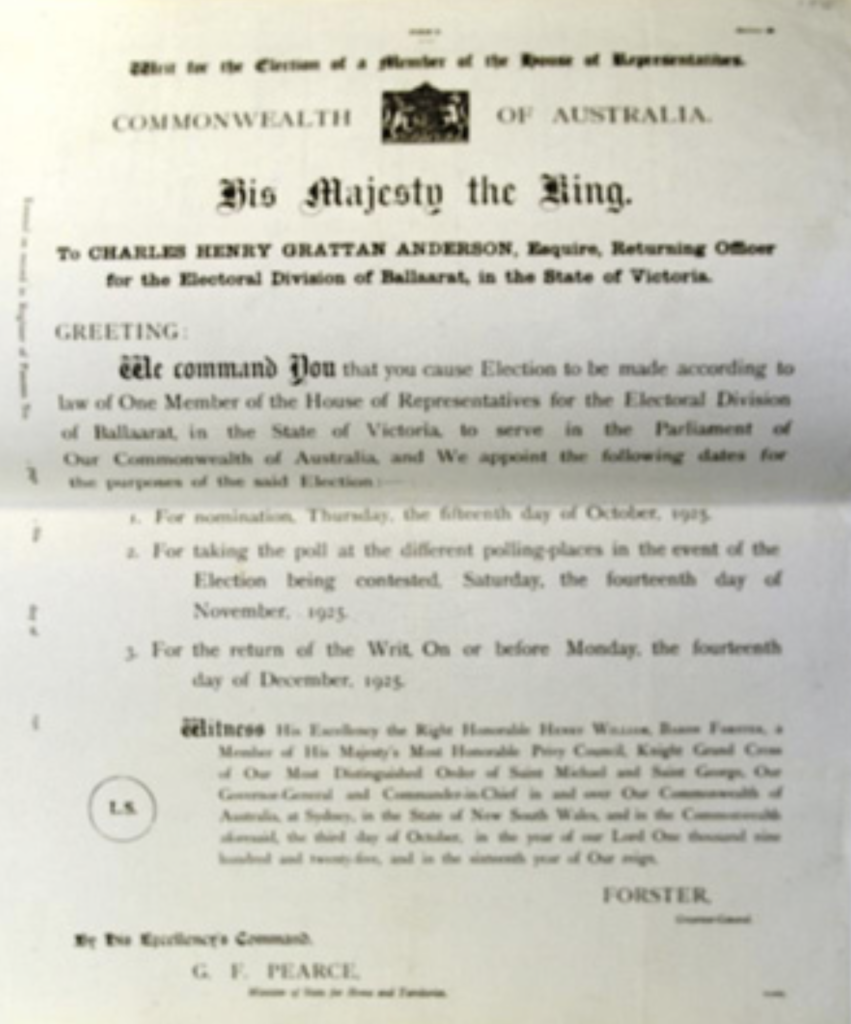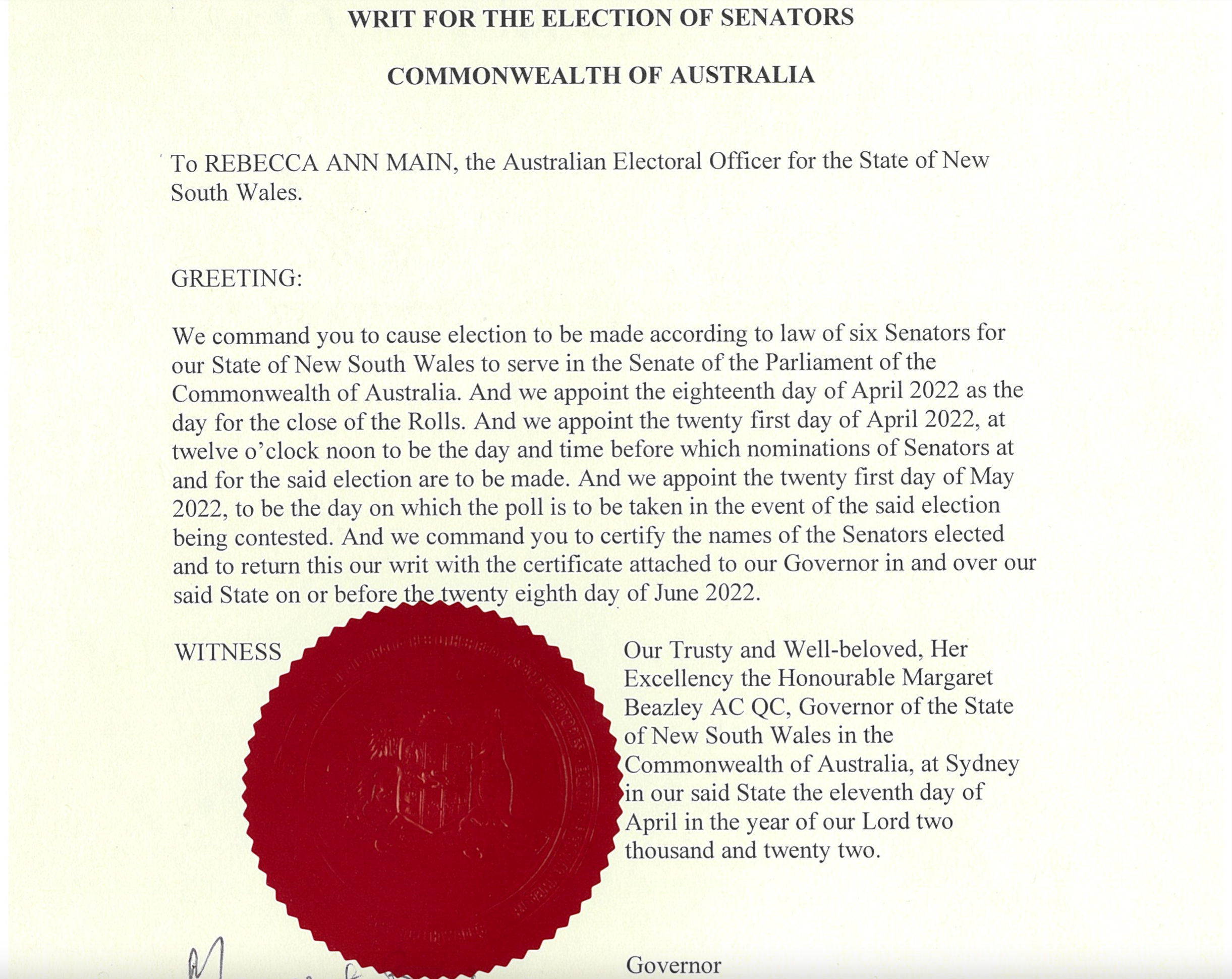There are many questions to be answered surrounding the issuing of writs for the federal election. Below is the government gazette evidencing writs were issued. Now the question is are the writs issued according to law? Is witnessing a document causing it to be issued? When the Governor General caused the writs to be issued did he do so on the advice of the Federal Executive Council in his role as the Governor in Council consistent with Section 32 and 63 of the Constitution?
COMMONWEALTH OF AUSTRALIA CONSTITUTION ACT - SECT 12.
The Governor of any State may cause writs to be issued for elections of senators for the State. In case of the dissolution of the Senate the writs shall be issued within ten days from the proclamation of such dissolution.
COMMONWEALTH OF AUSTRALIA CONSTITUTION ACT - SECT 32.
The Governor-General in Council may cause writs to be issued for general elections of members of the House of Representatives.
COMMONWEALTH OF AUSTRALIA CONSTITUTION ACT - SECT 63.
Provisions referring to Governor-General.
The provisions of this Constitution referring to the Governor-General in Council shall be construed as referring to the Governor-General acting with the advice of the Federal Executive Council.
It is quiet clear when the Governor General acts in his role as Governor General in Council, he is to do so with the advice of the Federal Executive Council (s63), when this occurs the governor proclaims the advice, he cannot act in an alternate capacity when acting 'In Council'.

It is clear this has not occurred when causing the writ to be issued.
Under section 61 of the Constitution of the Commonwealth of Australia, the executive power of the Commonwealth is vested in the Queen and is exercisable by the Governor-General. This power covers the execution and maintenance of the Constitution and the laws of the Commonwealth. The Federal Executive Council was established by section 62 of the Constitution to perform similar functions in Australia to those performed by the Privy Council in the United Kingdom, that is, to advise the Crown. It is the formal, constitutional and legal body responsible for advising the Governor-General (as distinct from Cabinet). The Executive Council is the legal means of ratifying executive acts by or on behalf of the Governor-General. Sections 62 and 64 of the Constitution provide for the Council to consist of Ministers and Ministers of State and Federal Executive Councillors under summons. They are required to advise the Governor-General regarding the Government of the Commonwealth. Meetings are held regularly, when Parliament sits, usually at Government House in Canberra. However, meetings may be held in other locations (e.g. Parliament House) depending on the number of Executive Councillors present. For this reason, the location of the Federal Executive Council has been taken as the location of the Federal Executive Council Secretariat in the Department of the Prime Minister and Cabinet. The location of the Federal Executive Council prior to 1936 is subject to further research, as for a time the offices of the Prime Minister's Department were located in Melbourne and Parliament House in Canberra (1927-1936). The Secretariat is responsible for organising meetings of the Federal Executive Council, ensuring that appropriate Cabinet approvals have been obtained, that appropriate inter ministerial consultation has taken place, that agreement has been reached and that the Executive Council documents reach the standard of quality required by the Council. Meetings of the Federal Executive Council may be convened by the Secretary to the Council after consulting the Governor-General is unavailable to preside at a meeting of the Council, the meeting may, with his prior agreement, be held in his absence. A quorum of the Council consists of: (a) the Governor- General and two Ministers; or (b) the Vice-President of the Federal Executive Council and two Ministers; or (c) three Ministers The work of the Federal Executive Council is mainly concerned with action to be taken under Acts of the Commonwealth Parliament. It therefore covers a wide spectrum of the Commonwealth's administration and includes such matters as: - the making of Proclamations and Regulations - the creation and abolition of government departments and positions in them - the issue of writs for the election of Members of the House of Representatives - the making and terminating of appointments to statutory offices on boards, commissions, councils and tribunals - the prohibition of import and export of certain commodities - the approval of compulsory land acquisitions - authorising entry into international treaties - authorising of government borrowings overseas - commissioning of officers in the armed services Business is submitted to the Executive Council by Minute; each Minute is accompanied by an Explanatory Memorandum. All Ministers, in their capacity as Executive Councillors under summons, may make recommendations for consideration by the Governor-General in Council. Consequently, if a Minister responsible for a particular Minute is absent or otherwise unavailable, the Minute may be signed by the Minister carrying out his or her duties or by another Minister on his or her behalf. This is provided for in section 19 of the Acts Interpretation Act 1901. Source: Commonwealth Government Directory, Volume 2, Federal Executive Council and Parliamentary Departments, March 1984.
In 2013 the ABC in the below story tells us writs are 'printed on heavy paper and has a traditional wax seal, quaint 19th century wording and font, and sets out the formal dates for all the required steps of the election'. 'The Commonwealth's writs are similar. They are definitely not the sort of document you print quickly in A4 from a laser printer.'
The writs for the six state Senate election are signed by each State's Governor. The drawing up of the writ and instruction to sign it are through the state's Executive Council, in effect on the advice of the Premier.
Various electoral Writs.
Below is a copy of a writ for the 2012 Queensland election,
Senate Writs
The 2022 New South Wales & Queensland Writ clearly provides the seal and endorsement required by the Commissioner but the other State writs are absent these requirements.
South Australia clearly has a seal embossed under the Governors signature.
Western Australia have clearly hidden the seal in use and there fails to be a signature of the Premier.
Victoria and Tasmania have failed to seal the writs.
Writs for the house of Representatives
COMMONWEALTH ELECTORAL ACT 1918 - SECT 153
Writs for election of Senators
(1) A writ for the election of Senators shall be addressed to the Australian Electoral Officer for the State or Territory for which the election is to be held.
(2) Where a writ for an election of Senators is received by the Australian Electoral Officer for a State or Territory under subsection (1), the officer shall:
(a) endorse on the writ the date of its receipt;
(b) advertise receipt of, and particulars of, the writ:
(i) in not less than 2 newspapers circulating generally in the State or Territory; or
(ii) if there is only one newspaper circulating generally in the State or Territory--in that newspaper;
(c) take such steps as the officer considers appropriate to advise each Divisional Returning Officer in the State or Territory of the dates fixed by the writ; and
(d) give such directions as the officer considers appropriate to each Divisional Returning Officer in relation to the holding of the election.
COMMONWEALTH ELECTORAL ACT 1918 - SECT 154
Writs for election of members of House of Representatives
(1) A writ for the election of a Member of the House of Representatives or for a general election for the House of Representatives shall be addressed to the Electoral Commissioner.
(4) Where a writ for an election to be held in a Division, or each Division, in a State or Territory is received by the Electoral Commissioner under subsection (1), the Commissioner shall:
(a) endorse on the writ the date of its receipt;
(b) advertise receipt of, and particulars of, the writ:
(i) in not less than 2 newspapers circulating generally in the State or Territory; or
Below the Governor General Acts under section 5 of the Constitution and seals with the Great Seal of Australia.

Below is a Commonwealth writ for the House of Representatives
showing there must be a seal next to the witness declaration,
The letters LS on the left represent where the seal is to be placed.

In 1998 there was an amendment to the Electoral Act via the Electoral and Referendum Amendment Act 1998, that on the face of it allows for preference votes (other than first preference votes) that in the opinion of the electoral officer can be used to preference the leading candidate most likely to be elected in that Division. This new amendment of 1998 allows for your vote to preference a candidate that was not the intention of the elector to occur.
ELECTORAL AND REFERENDUM AMENDMENT ACT 1992 No. 219 of 1992 - SECT 26
Scrutiny of votes in House of Representatives elections
26. Section 274 of the Principal Act is amended by inserting after subsection (2) the following subsections: "(2A) If, in a House of Representatives election, there are more than 2 candidates for a Division, the Australian Electoral Officer for the State or Territory that includes the Division must, in writing, direct the Assistant Returning Officers for the Division also to count such preference votes (other than first preference votes), on such of the ballot papers, as, in the opinion of the Australian Electoral Officer, will provide an indication of which candidate is most likely to be elected for the Division. "(2B) An Assistant Returning Officer to whom a direction is given under subsection (2A) must: (a) count the preference votes in accordance with the direction; and (b) transmit to the Divisional Returning Officer any information required by the direction; in the manner specified in the direction.".
